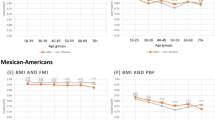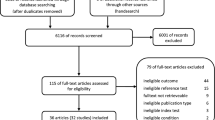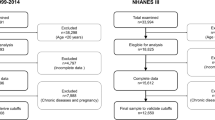Abstract
Objective:
To evaluate the validity of currently recommended obesity cutoffs of body mass index (BMI, in kg/m2) and waist circumference (WC, in cm) for Asians by the WHO/IASO/IOTF and for Chinese by the Working Group on Obesity in China (WGOC) using the percentage body fat (%BF)-obesity criteria.
Design:
A cross-sectional study.
Subjects:
A total of 1122 community-based Hong Kong Chinese women aged between 41 and 63 years.
Measurements:
Total %BF and percent truncal fat (%TF) were measured using dual-energy X-ray absorptiometry. Anthropometric indices were measured using standard methods.
Results:
Regression analyses showed that the BMI cutoffs of 23, 24, 25, and 28 kg/m2 corresponded to the %BF of 34.8, 35.9, 36.9 and 39.5%, and the 80 cm WC corresponded to 34% TF, respectively. Compared with the %BF obesity cutoff (⩾40%), the WHO/IASO/IOTF BMI-obesity criterion (⩾25) shows a good sensitivity (75%) and specificity (71%); and the WGOC criterion (BMI⩾28) had a low sensitivity (41%) but an excellent specificity (93%), respectively. Corresponding to the BMI cutoffs of 23, 24, 25 and 28 kg/m2, the %BF cutoffs associated with peak κ statistic were 33, 34, 35 and 40%, and the relevant %TF linked with 80 cm WC was 33%, respectively.
Conclusion:
BMI and WC have a good accuracy in the prediction of obesity. Our findings suggest that the WGOC BMI cutoffs are appropriate, but 80 cm of WC is a very rigorous cutoff for this population when using the criteria of 34 and 40% of body fat or truncal fat for overweight and obesity.
This is a preview of subscription content, access via your institution
Access options
Subscribe to this journal
Receive 12 print issues and online access
$259.00 per year
only $21.58 per issue
Buy this article
- Purchase on Springer Link
- Instant access to full article PDF
Prices may be subject to local taxes which are calculated during checkout




Similar content being viewed by others
References
Ho SC, Chen YM, Woo JL, Leung SS, Lam TH, Janus ED . Association between simple anthropometric indices and cardiovascular risk factors. Int J Obes Relat Metab Disord 2001; 25: 1689–1697.
Gregg EW, Cheng YJ, Cadwell BL, Imperatore G, Williams DE, Flegal KM et al. Secular trends in cardiovascular disease risk factors according to body mass index in US adults. JAMA 2005; 293: 1868–1874.
Flegal KM, Graubard BI, Williamson DF, Gail MH . Excess deaths associated with underweight, overweight, and obesity. JAMA 2005; 293: 1861–1867.
WHO. Obesity: preventing and managing the global epidemic. Report of a WHO consultation. World Health Organization Technical Report Series 2000; 894: i–xii.
Wu Y, Zhou B, Tao S, Wu X, Yang J, Li Y et al. Prevalence of overweight and obesity in Chinese middle-aged populations: current status and trend of development. Chinese J Epidemiol 2002; 23: 11–15.
Wang Y, Monteiro C, Popkin BM . Trends of obesity and underweight in older children and adolescents in the United States, Brazil, China, and Russia. Am J Clin Nutr 2002; 75: 971–977.
Matsushita Y, Yoshiike N, Kaneda F, Yoshita K, Takimoto H . Trends in childhood obesity in Japan over the last 25 years from the national nutrition survey. Obes Res 2004; 12: 205–214.
Yasumura S, Wang J, Pierson RN . In Vivo Body Composition Studies. New York Academy of Sciences: New York, 2000.
WHO/IASO/IOTF. The Asia-Pacific Perspective: Redefining Obesity and its Treatment. Health Communications Australia Pty Ltd: Melbourne, Australia, 2000.
Zhu S, Heymsfield SB, Toyoshima H, Wang Z, Pietrobelli A, Heshka S . Race-ethnicity-specific waist circumference cutoffs for identifying cardiovascular disease risk factors. Am J Clin Nutr 2005; 81: 409–415.
Wang J, Thornton JC, Russell M, Burastero S, Heymsfield S, Pierson Jr RN . Asians have lower body mass index (BMI) but higher percent body fat than do whites: comparisons of anthropometric measurements. Am J Clin Nutr 1994; 60: 23–28.
Chang CJ, Wu CH, Chang CS, Yao WJ, Yang YC, Wu JS et al. Low body mass index but high percent body fat in Taiwanese subjects: implications of obesity cutoffs. Int J Obes Relat Metab Disord 2003; 27: 253–259.
Deurenberg P, Deurenberg-Yap M, Guricci S . Asians are different from Caucasians and from each other in their body mass index/body fat per cent relationship. Obes Rev 2002; 3: 141–146.
WHO Expert Consultation. Appropriate body-mass index for Asian populations and its implications for policy and intervention strategies. Lancet 2004; 363: 157–163.
Zhou B, Cooperative Meta-Analysis Group Of China Obesity Task Force. Predictive values of body mass index and waist circumference to risk factors of related diseases in Chinese adult population. (Chinese). Chinese J Epidemiol 2002; 23: 5–10.
Zhou BF, Cooperative Meta-Analysis Group of the Working Group on Obesity in China. Predictive values of body mass index and waist circumference for risk factors of certain related diseases in Chinese adults – study on optimal cut-off points of body mass index and waist circumference in Chinese adults. Biomed Environ Sci 2002; 15: 83–96.
Ho SC, Chan SG, Yip YB, Cheng A, Yi Q, Chan C . Menopausal symptoms and symptom clustering in Chinese women. Maturitas 1999; 33: 219–227.
Chen YM, Ho SC, Lam SSH, Ho SSS, Woo JLF . Soy isoflavones have a favorable effect on bone loss in Chinese postmenopausal women with lower bone mass: A double-blind, randomized, controlled trial. J Clin Endocrinol Metab 2003; 88: 4740–4747.
Ho SC, Chen YM, Woo JLF, Lam SSH . High habitual calcium intake attenuates bone loss in early postmenopausal Chinese women: An 18-month follow-up study. J Clin Endocrinol Metab 2004; 89: 2166–2170.
Ho SC, Chen YM, Woo JLF . Educational level and osteoporosis risk in postmenopausal Chinese women. Am J Epidemiol 2005; 161: 680–690.
Ho SC, Gaen CS, Bing YY, Yee CS, Sham A . Factors associated with menopausal symptom reporting in Chinese midlife women. Maturitas 2003; 44: 149–156.
Molarius A, Seidell JC, Sans S, Tuomilehto J, Kuulasmaa K . Varying sensitivity of waist action levels to identify subjects with overweight or obesity in 19 populations of the WHO MONICA Project. J Clin Epidemiol 1999; 52: 1213–1224.
Gallagher D, Heymsfield SB, Heo M, Jebb SA, Murgatroyd PR, Sakamoto Y . Healthy percentage body fat ranges: an approach for developing guidelines based on body mass index. Am J Clin Nutr 2000; 72: 694–701.
Blew RM, Sardinha LB, Milliken LA, Teixeira PJ, Going SB, Ferreira DL et al. Assessing the validity of body mass index standards in early postmenopausal women. Obes Res 2002; 10: 799–808.
Dieurenberg P, Yap M, Van Staveren WA . Body mass index and percent body fat: a meta analysis among different ethnic groups. Int J Obes Relat Metab Disord 1998; 22: 1164–1171.
McGinn T, Wyer PC, Newman TB, Keitz S, Leipzig R, for GG, The Evidence-Based Medicine Teaching Tips Working Group. Tips for learners of evidence-based medicine: 3. Measures of observer variability (kappa statistic). Can Med Assoc J 2004; 171: 1369–1373.
Smalley KJ, Knerr AN, Kendrick ZV, Colliver JA, Owen OE . Reassessment of body mass indices. Am J Clin Nutr 1990; 52: 405–408.
Jackson AS, Stanforth PR, Gagnon J, Rankinen T, Leon AS, Rao DC et al. The effect of sex, age and race on estimating percentage body fat from body mass index: the heritage family study. Int J Obes Relat Metab Disord 2002; 26: 789–796.
Fernandez JR, Heo M, Heymsfield SB, Pierson Jr RN, Pi-Sunyer FX, Wang ZM et al. Is percentage body fat differentially related to body mass index in Hispanic Americans, African Americans, and European Americans? Am J Clin Nutr 2003; 77: 71–75.
Zhu S, Wang Z, Shen W, Heymsfield SB, Heshka S . Percentage body fat ranges associated with metabolic syndrome risk: results based on the third National Health and Nutrition Examination Survey (1988–1994). Am J Clin Nutr 2003; 78: 228–235.
Clasey JL, Bouchard C, Teates CD, Riblett JE, Thorner MO, Hartman ML et al. The use of anthropometric and dual-energy X-ray absorptiometry (DXA) measures to estimate total abdominal and abdominal visceral fat in men and women. Obes Res 1999; 7: 256–264.
Gallagher D, Visser M, Sepulveda D, Pierson RN, Harris T, Heymsfield SB . How useful is body mass index for comparison of body fatness across age, sex, and ethnic groups? Am J Epidemiol 1996; 143: 228–239.
Acknowledgements
The authors wish to thank the Hong Kong Health Services Research Fund (Ref. No. 831010) for partial support of the study.
Author information
Authors and Affiliations
Corresponding author
Rights and permissions
About this article
Cite this article
Chen, YM., Ho, S., Lam, S. et al. Validity of body mass index and waist circumference in the classification of obesity as compared to percent body fat in Chinese middle-aged women. Int J Obes 30, 918–925 (2006). https://doi.org/10.1038/sj.ijo.0803220
Received:
Revised:
Accepted:
Published:
Issue Date:
DOI: https://doi.org/10.1038/sj.ijo.0803220
Keywords
This article is cited by
-
The effect of obesity on periodontitis progression: the 10-year retrospective cohort study
Clinical Oral Investigations (2022)
-
Body mass index, waist circumference, waist-to-hip ratio, and body fat in relation to health care use in the Canadian Longitudinal Study on Aging
International Journal of Obesity (2021)
-
Comparison of anthropometric and body composition indices in the identification of metabolic risk factors
Scientific Reports (2021)
-
Beyond Asian-Specific Cutoffs: Gender Effects on the Predictability of Body Mass Index, Waist Circumference, and Waist Circumference to Height Ratio on Hemoglobin A1c
Journal of Racial and Ethnic Health Disparities (2021)
-
The performance of anthropometric tools to determine obesity: a systematic review and meta-analysis
Scientific Reports (2020)



